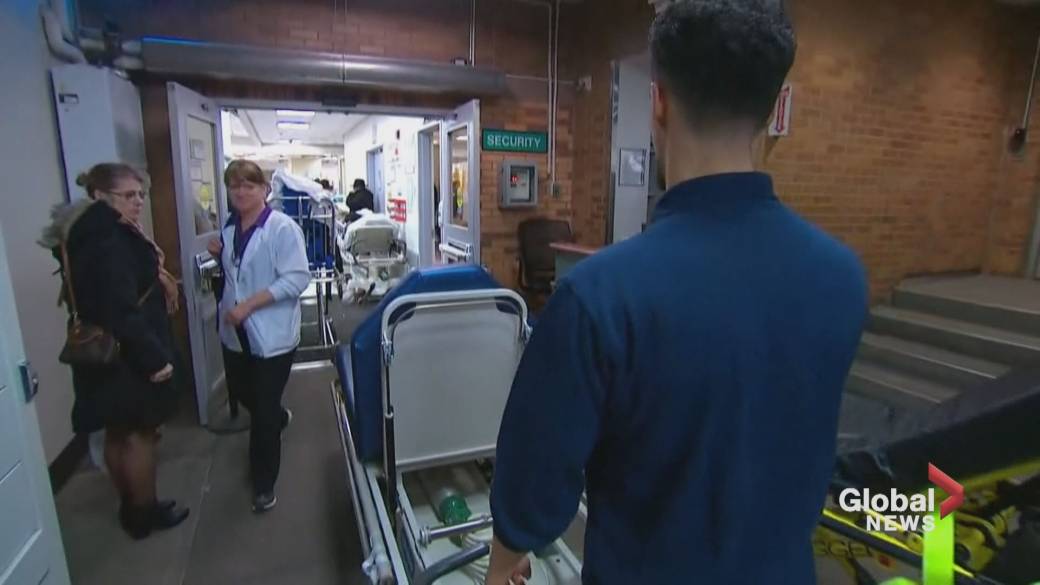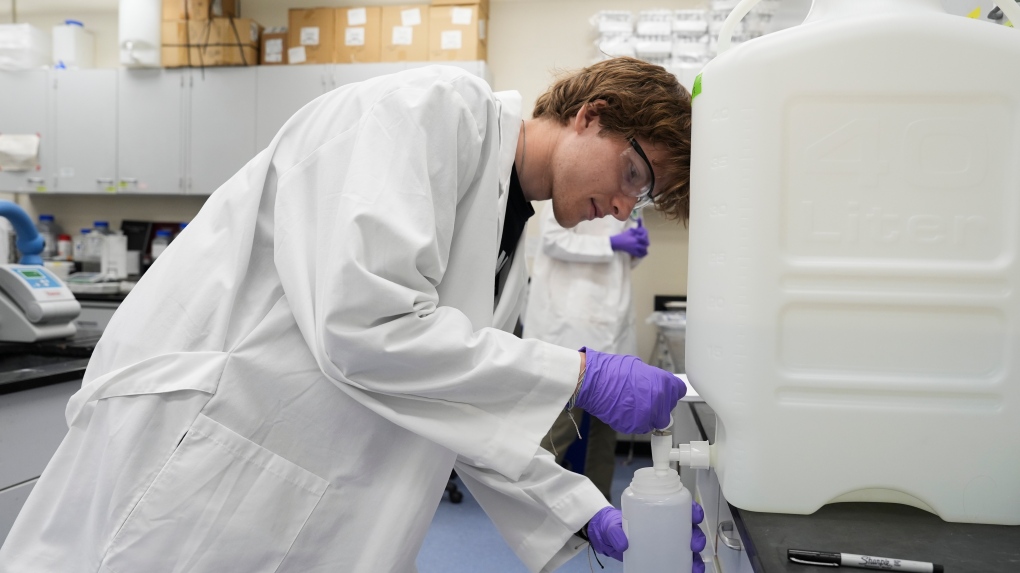News
Canada hits over 10,000 confirmed COVID-19 cases – Global News

As the coronavirus pandemic continues to spread throughout several parts of Canada, the country hit more then 10,000 confirmed cases on Thursday.
Ontario announced 401 more cases on April 2, putting the total for country at over 10,000 cases. That’s a stark increase compared to where the country was on March 1, with only 24 confirmed cases at that time.
Dr. Theresa Tam, Canada’s chief public health officer acknowledged the country reaching over 10,000 cases in a press conference on April 2.
“These represent infections from previous exposures and not what is happening right now necessarily,” she said.
“So even if you’re not hearing of cases in your community, it doesn’t mean there is no risk of exposure. We must all consider that anyone could be infected and keeping our two-metre distance is the safest bet,” she explained.
The provinces of Ontario, British Columbia and Quebec have the highest numbers of COVID-19 cases.
Canada’s total death toll also surpassed 120 this week.
There also continues to be ongoing concern for Indigenous communities along with retirement homes and correctional facilities, where vulnerable people are in close quarters with others.
So far, there have been outbreaks and deaths in some of these spaces, said Tam at a press conference on March 31.
Multiple provinces including B.C., Alberta and Ontario have seen a string of COVID-19-related deaths stemming from outbreaks at nursing homes and long-term care facilities, raising concerns about how protected residents and care workers in those facilities are.
The chart below only includes confirmed cases, not presumptive cases. To see all the presumptive cases in the country, see Health Canada’s chart here.
Understanding the current cases and increase
The Public Health Agency of Canada reports that community transmission applies to 64 per cent of Canada’s COVID-19 cases, meaning those people were infected without travelling or being close to someone who has a confirmed case.
The extent of community spread cases can be difficult to track based on testing rates and if some people are asymptomatic, they know they are carrying the illness.
Thirty-six per cent of the cases are due to travel or a person being exposed to a traveller returning to Canada. So far, this data applies to 4,183 confirmed Canadian cases, according to the Public Health Agency.
As Canada’s total case count surpasses 10,000, Chief Public Health Officer Dr. Theresa Tam says what the new numbers don’t show is the point in time when people became sick, she said at a recent press conference.
[ Sign up for our Health IQ newsletter for the latest coronavirus updates ]
“What you’re seeing today is what happened to someone when they were symptomatic at least two weeks ago,” she said.
Finding context in cases and the source of outbreaks can be difficult for public health agencies to discern and it will take some time to analyze whether social distancing and closures have made an impact in the last few weeks, she explained.
This week, however, is “crucial” to see whether these protocols have had any effect.
“There are still outbreaks connected to a number of high-risk settings in Canada, particularly in long-term care facilities. So there’s still an urgent need to double-down on precautions,” she said.
“While many cases occur in younger adults, it really is people over the age of 60 who account for 60 per cent of the hospitalizations and 90 per cent of deaths. The high-risk population needs to take every precaution.”
More Canadians continue to be tested
Testing efforts have also ramped up across the provinces, with more than 222,000 Canadians having been tested as of March 30. However, Ontario has faced criticism for their backlog of tests that had grown to just under 11,000 as of a week ago.
A Global News data analysis found that Ontario had the lowest testing rates at 351 per 100,000. In comparison, B.C. has a rate of 846 people tested per 100,000 as of April 1.
Ontario is still working through a backlog of cases, which is why the province is reporting increases in the hundreds recently, explained Christine Ontario Health Minister Christine Elliott at a press conference on April 1.
On March 31, the province tested 6,245 people in one day, which is double the number of people tested from the day before.
“The cases that are currently being diagnosed are really historic cases, looking back at what has happened over the last week to 10 days,” said Elliott.
“What’s going to be most important is what we are going to see when the backlog is cleared over the next day or so. We will then be dealing with current information and that is what’s going to tell us where we are in terms of flattening the curve.”
Do we know what will happen next?
On March 27, B.C.’s health officials released their own data predictions about what’s in store for the province. The modelling showed that the province’s transmission rate had dropped from 24 per cent to 12 per cent.
Researchers compared B.C.’s COVID-19 growth rate to other regions like South Korea, northern Italy and Hubei province in China to see how B.C.’s hospitals would be able to handle the spread of the virus. The results showed B.C. is similar to having a scenario like South Korea and if that analysis is accurate, the province would have enough hospital beds and ventilators.
However, Tam has warned that Canada is a “big country” and outcomes may vary starkly between provinces and territories.
While the B.C. data is “promising,” we should be “very cautious in making any definitive claims and even more so when it comes to generalizing these findings to other provinces,” said Dr. Suzanne Sicchia, an associate professor at the Interdisciplinary Centre for Health and Society at the University of Toronto Scarborough, in a previous Global News report.
This week and next week are crucial for health officials as they will give them a better sense of whether measures taken to flatten the curve are actually effective, she said.
“To these ends, the experts will be watching to see if there is a decrease in the rate of new, confirmed cases,” Sicchia said..
This week we may also see many beginning to have symptoms based on what’s known about the virus’ incubation period, according to Dr. Jeff Kwong, an infectious disease specialist and associate professor in the department of family and community medicine at the University of Toronto in a previous Global News report.
“It’s going to be this week or the next week that we’re going to see a wave of people who are really sick,“ Kwong said.
“We know there’s lots cases out there — most are mild — but how many of all these cases are going to be severe?” he said. “That’s what we’re going to start to see this week.”
According to Public Health, COVID-19 is a “serious health threat” and numbers continue to change on a daily basis.
“The risk will vary between and within communities, but given the increasing number of cases in Canada, the risk to Canadians is considered high,” the organization noted.
However, Public Health wants to ensure the public understand not all Canadians will get the disease. The focus should continue to be flattening the curve by physical distancing, self-isolation if you have any symptoms or recently travelling and staying home as much as you can.
Questions about COVID-19? Here are some things you need to know:
Health officials caution against all international travel. Returning travellers are legally obligated to self-isolate for 14 days, beginning March 26, in case they develop symptoms and to prevent spreading the virus to others. Some provinces and territories have also implemented additional recommendations or enforcement measures to ensure those returning to the area self-isolate.
Symptoms can include fever, cough and difficulty breathing — very similar to a cold or flu. Some people can develop a more severe illness. People most at risk of this include older adults and people with severe chronic medical conditions like heart, lung or kidney disease. If you develop symptoms, contact public health authorities.
To prevent the virus from spreading, experts recommend frequent handwashing and coughing into your sleeve. They also recommend minimizing contact with others, staying home as much as possible and maintaining a distance of two metres from other people if you go out.
For full COVID-19 coverage from Global News, click here.
— With files from Global News’ Emerald Bensadoun, Patrick Cain, Hannah Jackson and Amanda Connolly.
© 2020 Global News, a division of Corus Entertainment Inc.
News
14 suspects arrested in grandparents scam targeting seniors across Canada: OPP – CP24


An interprovincial investigation into an “emergency grandparents scam” that targeted seniors across Canada has led to the arrest of 14 suspects, Ontario Provincial Police say.
Details of the investigation, dubbed Project Sharp, were announced at a news conference in Scarborough on Thursday morning.
Police said 56 charges have been laid against the suspects, who were all arrested in the Montreal area.
According to police, since January, investigators identified 126 victims who were defrauded out of a total of $739,000. Fifteen of those victims were defrauded on multiple occasions, police said, resulting in the loss of an additional $200,000.
The victims, who range in age from 46 to 95, were targeted based on the fact that they had landline telephones, police said. While people across the country were defrauded, police said, the majority resided in Ontario.
Police said four of the 14 arrested in the fraud remain in custody while the other 10 have been released on bail. The charges they face include involvement in organized crime groups, extortion, impersonating a police officer, and fraud, police said.
OPP Det.-Insp. Sean Chatland told reporters Thursday that the police service began looking into an “organized crime group” believed to be involved in fraud during an intelligence probe in September 2022.
By February 2023, Chatland said the probe was formalized into an OPP-led joint forces investigation involving police services in both Ontario and Quebec.
“This organized crime group demonstrated a deliberate and methodical approach in exploiting victims. They operated out of Ontario and Quebec, utilizing emergency grandparents scams on victims across Canada,” Chatland said.
“They would impersonate police officers, judges, lawyers, and loved ones, preying on grandparents who believed they were trying to help family members in trouble.”
He said in many cases, the suspects utilized “money mules” or couriers to collect large sums of money from the victims.
This is a breaking news story. More details to come.
News
PQ leader unapologetic about comments made regarding Canada – CTV News Montreal


Parti Québécois (PQ) Leader Paul St-Pierre Plamondon isn’t shying away from criticism that comments he made referencing Canada’s colonial past were an inappropriate way to push his party’s sovereignty agenda.
“We need to be considering the whole history of Canada in interpreting what’s happening,” he told CJAD 800’s Aaron Rand.
This comes just days after St-Pierre Plamondon assured that Quebecers “will definitely be living through a third referendum” on sovereignty before the end of the decade if his party is elected.
His reasoning: the federal government poses an “existential threat” to Quebecers.
“What will become of us as Quebecers if we don’t even have a fifth of the votes in a government that decides for us? We’re finished. Canada has a bleak future in store for us,” he told party members at a two-day national council on housing. “It’s a regime that only wants to crush those who refuse to assimilate.”
In speaking with Rand on Wednesday about backlash to his comments, St-Pierre Plamondon pointed out, “I’m not always soft-spoken but I always try to be as thoughtful as possible.”
Nevertheless, he doubled down on his argument, saying the federal government was “disrespecting” the provinces when it comes to issues like immigration.
“That doesn’t give us any hopes of integration, and housing, and of providing services for these people under the federal power of immigration,” he said.
Plamondon stated that there are currently 560,000 temporary immigrants in Quebec, and if the federal government continues on this path, “there is no viable future for Quebec.”
LISTEN ON CJAD 800 RADIO: PQ leader accuses Canada of ‘disrespecting the competencies of provinces’
He also refused to apologize for referencing Canada’s history, saying the country shouldn’t shy away from its past.
“Talking about history is not being radical even though the [Quebec Liberal Party] PLQ or Éric Duhaime tries to distort what I said to make me a radical politician,” he said. “I don’t think people will buy that because I’ve been constant for the past years, and talking about history shouldn’t be radical in my view.”
He points out that his criticisms aren’t specifically aimed at Prime Minister Justin Trudeau or his Liberal Party but at the federal government in general.
“He’s continuing the mission of his father. He has the exact same approach toward Quebec, and that’s fair to do,” St-Pierre Plamondon said. “If we live in a world where the past never happened, it’s difficult to have an appropriate reading of what’s actually happening right now if we have no notion of what happened before.”
He says his beliefs will not change no matter who is in power.
The next federal election is slated to take place on or before Oct. 20, 2025.
News
Drinking water quality: Canada's plan for forever chemicals – CTV News


As the United States sets its first national limits on toxic forever chemicals in drinking water, researchers say Canada is lagging when it comes to regulations.
Still, they acknowledged that Canada is making progress in trying to reduce and prevent the contamination of water in the country.
From carpeting to non-stick cookware, so-called forever chemicals, or perfluoroalkyl and polyfluoroalkyl substances (PFAS), have been widely found in consumer products since the 1950s.
These chemicals are designed to be so strong that they don’t break down fully in the environment. They’re used to make products non-stick, oil- and water-repellent and resistant to temperature change.
Growing evidence shows PFAS are in Canadian freshwater sources and drinking water, according to Health Canada. Studies have linked PFAS to serious health problems, such as cancer, low birth weight and liver disease.
The U.S. Environmental Protection Agency (EPA) finalized its drinking water regulation for six PFAS last week. Under the new regulation, utilities are required to limit certain forever chemicals, including two common types —perfluorooctane sulfonic acid (PFOS) and perfluorooctanoic acid (PFOA) — to four parts per trillion, or four nanograms per litre. As well, water providers must test for these PFAS and alert the public when levels are too high.
Similarly, Health Canada proposed new limits for PFAS in drinking water in February 2023. There are currently drinking water quality guidelines for PFOA and PFOS in Canada.
Under the current guidelines, the limit is 200 ng/L for PFOA, which is 50 times more than the U.S. limit of 4 ng/L. At 600 ng/L for PFOS, the maximum allowable amount in Canada for this type of forever chemical is 150 times more than the U.S limit.
In light of the changes south of the border, CTVNews.ca asked Health Canada whether there were any plans to change the limits, or to follow the American lead on the issue.
In a recent email to CTVNews.ca, Health Canada spokesperson Mark Johnson said the department has proposed a drinking water objective with a much lower limit of 30 ng/L for all PFAS detected in drinking water.
Canada’s strategy
Despite Canada’s proposed drinking water limit for PFAS being about eight times higher than the ones for the United States, many factors are probably at play, according to an expert.
Satinder Kaur Brar, a civil engineering professor and James and Joanne Love Chair in Environmental Engineering at York University in Toronto, has been doing work for the past few decades on various contaminants including PFAS in waters and wastewaters.
“Definitely U.S. EPA has taken a leap forward in this direction,” she said in a video interview with CTVNews.ca, noting no international standards exist. “So I would say that if we have set up higher limits here for the Canadian citizens, definitely we are exposing them more, or making them more vulnerable to these chemicals.”
Canada’s recently proposed limits only deal with drinking water, not other contaminated sources such as food, soils, sediments and air, Brar pointed out. She points to political leaders as being among those to blame for what some may perceive as holes in the proposed policy changes.
“I would say that the political will is also lacking because political will also plays an important role in bringing out these regulations,” she said. “We have left out many important environmental compartments, which are all interlinked and contributing to the overall … presence of PFAS in water.”
‘Stringent enough’?
And when it comes to laws and regulations, a senior environmental law researcher and paralegal says Canada has made strides in tackling the problem, but it’s lagging behind some countries such as the U.S.
“So while the U.S. EPA numbers are set much lower than Canada’s, what we see in Canada is at least a progression from the current guidelines, and that’s not a bad thing,” Fe de Leon, with the Canadian Environmental Law Association in Toronto, said in a video interview with CTVNews.ca.
“The question is whether it’s stringent enough to deal with the scope of impacts that these chemicals have on the environment and particularly human health.”
Health Canada’s Johnson said the final drinking water objective for PFAS will be published later this year, replacing current guidelines. Provinces and territories use these guidelines and objectives to create drinking water quality requirements for all Canadians, he said.
Provincial and territorial authorities have been monitoring treated drinking water in some regions, and the federal government has been monitoring PFAS in freshwater since 2013, Johnson added.
“Current data regarding PFAS in Canadian freshwater sources and drinking water suggest that PFAS are present at levels below the new proposed objective,” Johnson said in an emailed statement. “However, the concentrations of PFAS in freshwater and drinking water may be higher near facilities that use large amounts of these chemicals, locations where firefighting foams containing PFAS were used to put out a fire, and landfills and wastewater treatment plants.”
‘The biggest issue’
A major problem is a lack of information on the forever chemicals affecting Canadians, many of whom may be unaware of what these chemicals are, where they’re found and the impact they can have on our health and the world around us.
“The biggest issue right now is complete disclosure of how many of these chemicals are actually found in the Canadian market and are being released into the environment,” Brar said. “We don’t have a good handle on that.”
Over the last few years, she said, more sites across Canada have been “impacted substantially” by PFAS. “So this is absolutely necessary that the government moves ahead and takes action on these chemicals, and create their own strategy.”
A chemical engineering professor who leads a team that conducts research on the impacts of these chemicals says he believes that both Canada and the U.S. have made their boldest moves so far to address the problem.
“The net effect is that both the U.S. and Canada are trying to limit … these chemicals in drinking water to levels that are extremely low and barely measurable,” said Franco Berruti, director at the Institute for Chemicals and Fuels from Alternative Resources at Western University in London, Ont., in a video interview with CTVNews.ca. “At the end of the day …they will have the similar effect.”
Barriers to a solution
Berruti said there isn’t a simple solution to the problem of controlling the impact of forever chemicals. One of the barriers to regulating them is the many unknowns about PFAS.
“It’s not just a question of two or three chemicals that are considered toxic that one would regulate. But we are talking about thousands and thousands of these chemicals. We don’t even know how to analyze these chemicals,” he said.
The technologies that exist to reduce or eliminate PFAS “are very limited,” Berruti added.
Scientists are still studying different aspects of the problem, including investigating which forever chemicals are more problematic and measurable.
Out of more than 12,000 types of PFAS, Berruti estimates that only 40 may be measurable.
“To set the limits without having the ways of measuring those … extremely low concentrations doesn’t mean anything until the methodologies are there to demonstrate that those limits are reached,” he said.
While Canada doesn’t produce PFAS, Berruti said, the country should closely monitor the imports of products that are contaminated with the chemicals.
Industry concerns
Health advocates praised the U.S. move to create its first drinking water limits on PFAS, but the news wasn’t universally celebrated.
Among the concerns raised were those from water utilities, which said customers will end up paying more for water since treatment systems are expensive to install.
Actions taken in Canada have also been met with challenges and criticism.
In May 2023, Health Canada issued a draft recommendation to label PFAS, an entire class of chemicals, as toxic under the Canadian Environmental Protection Act.
Cassie Barker, the toxics program manager at Environmental Defence, said in March that it was important to label the entire class, not only each individual substance, as toxic, The Canadian Press reported. When Canada designated and banned some types of PFAS in 2012, Barker said, it became a “whack-a-mole” situation, because other products used to replace them also posed health risks.
In response to the proposed PFAS toxic designation, the Chemistry Industry Association of Canada wrote to Environment and Climate Change Canada in June 2023 asking that PFAS not be labelled toxic as an entire class of substances, and instead be designated on a case-by-case basis, based on proven risk.
PFAS currently used by Canadian industry “have not been shown to be of high risk” and sweeping prohibitions could cause economic hardship to the industry, it wrote in its letter.
In the States, growing awareness has led to lawsuits against manufacturers.
For example, 3M settled a series of lawsuits last June that could exceed US$12.5 billion, involving more than 300 U.S. municipalities where the chemicals were found in drinking water. The company said it plans to stop making PFAS by 2025.
In the same month, DuPont de Nemours Inc. and spinoffs Chemours Co. and Corteva Inc. reached a US$1.18-billion deal over similar complaints by about 300 drinking water providers.
And legal action has occurred in Canada as well.
According to the business law firm Osler, a class action was certified in 2021 against the National Research Council of Canada over PFAS in the surface water and groundwater at the NRC’s facility in Mississippi Mills, Ont.
With files from The Associated Press and The Canadian Press
-
Business23 hours ago
Rupture on TC Energy's NGTL gas pipeline sparks wildfire in Alberta – The Globe and Mail
-
Investment23 hours ago
Saudi Arabia Highlights Investment Initiatives in Tourism at International Hospitality Investment Forum
-



 Tech16 hours ago
Tech16 hours agoCytiva Showcases Single-Use Mixing System at INTERPHEX 2024 – BioPharm International
-
Art23 hours ago
Squatters at Gordon Ramsay's Pub Have 'Left the Building' After Turning It Into an Art Café – PEOPLE
-



 Science22 hours ago
Science22 hours agoNasa confirms metal chunk that crashed into Florida home was space junk
-



 Politics23 hours ago
Politics23 hours agoThe Earthquake Shaking BC Politics
-
News18 hours ago
Tim Hortons says 'technical errors' falsely told people they won $55K boat in Roll Up To Win promo – CBC.ca
-



 Investment22 hours ago
Investment22 hours agoBill Morneau slams Freeland’s budget as a threat to investment, economic growth













